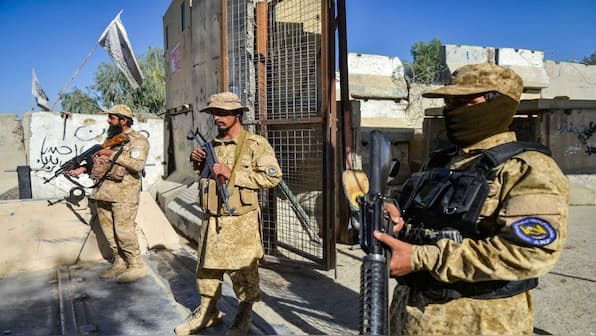
The ongoing conflict between Afghanistan and Pakistan along the Durand Line has intensified once again. Local reports confirm that heavy fighting is underway between the Afghan Taliban and the Pakistani military in the Spin Boldak region. According to Tolo News, citing Spin Boldak district information chief Ali Mohammad Iqbal, both light and heavy weaponry are being used in the clashes. The Pakistani military has been firing artillery shells during the ongoing confrontation.
Renewed Clashes Along the Durand Line
The clashes between Afghan Taliban forces and Pakistani soldiers erupted early in the morning of Wednesday, around 4 AM. The fighting is concentrated in Spin Boldak, a key area near the Afghan-Pakistani border. Reports suggest that the conflict involves both sides utilizing artillery, small arms, and other military hardware, contributing to the intensity of the battle. The Pakistani military’s artillery has caused significant damage to civilian homes, forcing many residents to flee their homes for safety.
Tolo News further reported that while there have been no confirmed fatalities as of the morning of the clashes, the civilian areas, especially homes in Spin Boldak, have been heavily impacted by the artillery fire. As a result, many local residents were seen fleeing their homes to escape the bombardment. The situation in other areas near the Afghan-Pakistani border, such as Chaman, has also been tense, with continued skirmishes reported between Afghan security forces and the Pakistani military. These ongoing clashes have caused significant casualties on the Pakistani side.
Afghan Defense Forces Attack Pakistani Army
The tensions between the two forces have been escalating since the previous days. On Tuesday evening, the Afghan defense forces launched a counterattack against the Pakistani army. According to reports, the attack resulted in the deaths of at least seven Pakistani soldiers. The spokesperson for the Governor of Khost province confirmed to Tolo News that the Pakistani military had attempted to launch an attack first, but Afghan forces successfully repelled the assault. Later, around 7 PM, Afghan forces launched a retaliatory strike in the Jaji Maidan district, which targeted Pakistani military positions.
Rising Tensions Between Pakistan and the Taliban
Tensions between Pakistan and the Taliban had been escalating prior to these clashes. Last week, the Pakistani Air Force carried out airstrikes in Kabul, targeting the leader of Tehrik-i-Taliban Pakistan (TTP), Noor Wali Mehsud. However, Mehsud responded with an audio message, confirming that he was not in Kabul as the airstrikes suggested. Instead, he was in Pakistan’s tribal areas, contradicting Pakistan’s claims regarding the target of their airstrikes.
In the wake of the airstrike, the Afghan Taliban launched several attacks on Pakistani military installations along the Afghanistan-Pakistan border on the night of October 11 and 12. Reports from the Taliban indicated that these attacks resulted in the deaths of 59 Pakistani soldiers. On the Afghan side, nine Afghan soldiers also lost their lives during the strikes. The Taliban also mentioned that the attacks were halted upon requests from Qatar and Saudi Arabia, indicating the international pressure to de-escalate the situation.
The Wider Implications of the Conflict
The ongoing skirmishes between Afghan Taliban forces and the Pakistani military highlight the fragile situation in the region. The conflict is not only a bilateral issue but has broader implications for regional security and international relations. The Durand Line, a contentious border drawn during the British colonial era, has long been a flashpoint between the two countries. The Afghan government, even before the Taliban’s resurgence, had never fully accepted the line as an official border. This has led to frequent disputes over territorial control, border security, and cross-border militancy.
The military clashes and the increased tension between the Taliban and Pakistan also reflect a deeper, more complex geopolitical struggle. While Pakistan has long been accused of providing support to various insurgent groups within Afghanistan, the Taliban’s recent resurgence has challenged Pakistan’s strategic interests. The ongoing fighting, therefore, is not just a military issue but also part of a larger struggle over regional dominance, influence, and security.
Diplomatic Efforts and International Concerns
The involvement of third parties like Qatar and Saudi Arabia in calling for de-escalation suggests that the international community is closely monitoring the situation. Both countries have played key roles in mediating peace talks and facilitating dialogue between Afghanistan’s various factions. However, despite these diplomatic efforts, the situation on the ground remains volatile.
The clash between the Afghan Taliban and Pakistan’s military also draws attention to the fragile state of peace in Afghanistan after the U.S. withdrawal. While the Taliban had promised to honor a peace agreement with the United States, their conduct towards neighboring countries like Pakistan has shown that long-standing regional tensions have yet to be fully resolved. The ongoing violence underscores the challenges faced by Afghanistan as it attempts to stabilize its internal situation while dealing with external pressures and conflicts.
As the situation in Spin Boldak and along the Afghan-Pakistani border remains tense, the future of the region’s stability seems uncertain. The fighting between the Afghan Taliban and Pakistani forces is not only a reflection of the broader historical tensions between the two nations but also a manifestation of the evolving geopolitical landscape in South Asia.
The international community, including neighboring countries and global powers, will continue to urge both sides to de-escalate and seek a peaceful resolution to the conflict. However, given the historical complexities of the region, finding a long-term solution will require significant diplomatic efforts, a commitment to peace, and addressing the underlying issues that fuel the ongoing violence.
The situation remains fluid, and further developments are expected in the coming days. As the conflict unfolds, the international community will be closely watching the actions of both the Taliban and the Pakistani military, hoping for a resolution that can bring stability to a region that has seen decades of unrest.


